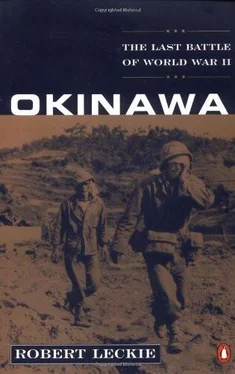Both to Captain Gehres and Rear Admiral R. E. Davison, commander of Task Group 58.2, it was clear that Franklin was badly hurt and might go under. To continue to direct his ships and planes against the enemy, Davison had no other choice but to remove his flag to another ship. But as he prepared to board the light cruiser Santa Fe, which he had ordered to come alongside the blazing Franklin to help fight fires and take off wounded, he was pleased to hear Gehres flatly reject any proposal to abandon ship. Gehres knew that perhaps three hundred of his men were trapped below in a mess compartment beneath the blazing hangar deck. “I had promised these kids I’d get them out,” he explained. Meanwhile, Dr. J. L. Fuelling, a ship’s physician, calmed the trapped sailors by ordering them to sit quietly and not consume oxygen by talking. As they sat terrified—who would not be?—in the stifling heat, the only air reaching them came from a hole in the ship’s side just big enough to pass a baseball through. It is probable that they might have suffocated if not rescued soon, and that succor did come from a brave junior-grade lieutenant named Donald Cary.
As ship’s fuel and water officer, Cary was familiar with the maze of passageways and compartments belowdecks, and he relied upon this knowledge to grope his way to locate the trapped bluejackets and lead them topside to safety—a daring feat for which he received a Medal of Honor.
That highest military award in the gift of the United States also went to Chaplain Joseph O‘Callahan. To Commander Stephen Jurka, Franklin’s navigator, Father O’Callahan was “a soul-stirring sight. He seemed to be everywhere, giving Extreme Unction to the dead and dying, urging the men on and himself handling hoses, jettisoning ammunition and doing everything he could to save the ship.” He seemed as composed as his Master moving through the smoke with the cross on his helmet shining like a beacon, “his head bowed slightly as if in meditation or prayer.” Marveling at his serenity, Captain Gehres said: “I never saw a man so completely disregard the danger of being killed …”
Perhaps the most awesome feat of seamanship during Franklin’s entire ordeal came from Captain Hal Fitz of the Santa Fe, who daringly slammed into the carrier’s side, remaining there to fight fires and take off wounded as well as able sailors. In spite of continuing explosions like strings of giant firecrackers, Fitz doggedly held Santa Fe fast, his own hoses joining Franklin’s in dousing flames, meanwhile taking aboard eight hundred of the carrier’s seamen.
By noon the fires were dying down and the explosions less frequent and dangerous. But Franklin was still dead in the water, her black gangs having been driven from the engine rooms by intense heat. Commandeering a pickup force of messmen, Commander Taylor successfully seized a towline from the heavy cruiser Pittsburgh and began a crawling withdrawal from Japanese waters at a limping speed of six knots. That night a special detail equipped with breathing apparatus reduced Franklin’s dangerous list of thirty degrees while a party of daring volunteers braved smoke and heat to enter a boiler room and relight a pair of boilers. Franklin began to move under its own power.
The next day, with six boilers operating, the carrier dropped the Pittsburgh tow and went cleaving through the waves at a spanking fifteen knots. But then, in early afternoon, hearts breathing free at last constricted in fear again when another bold Judy bomber came gliding out of the sun. Without power to operate the flattop’s plentiful AA guns, Franklin appeared helpless—until another crew of volunteers wrestled a heavy quadruple 40 mm gun mount around and fired it so accurately that the Judy was forced to nose upward at its release point, and its bombs—almost grazing the carrier—exploded harmlessly in the sea about two hundred feet from the ship.
Soon Franklin was out of the impact area. Captain Gehres now took stock of his human losses. He was shocked to find that 724 of his men had been killed and another 1,428 either wounded or unavailable and presumed to be aboard the five destroyers and two cruisers assigned to rescue duty. But there were still 103 officers and 603 enlisted men present able to sail the ship, although many of them were still in shock. Rather than have many more succumb to the paralysis of combat fatigue, Gehres wisely instituted a program of punishing and distracting work: burying their fallen comrades at sea, clearing the decks of wreckage, and scouring blackened compartments. By the time Franklin reached Pearl Harbor, those who saw her decks looking like “a shredded wheat biscuit” were amazed that she had survived the four-thousand-mile voyage back to base; and when her anchors went clattering down the hawse pipes off New York’s Brooklyn Navy Yard she looked “almost presentable.” In truth, because of her gallant skipper and crew, Franklin was by far the most shattered carrier on either side to survive its ordeal.
With Wasp and Franklin out of action, Admiral Spruance at once reduced his striking strength to three groups, distributing his remaining vessels among them, after which—with a few farewell sweeps over still-numbed and battered Kyushu—he retired far out to sea to refuel. Spruance’s flyers claimed a total of five hundred enemy planes destroyed, three hundred shot down in air battles: an estimate that seems exaggerated. Still, they had certainly decimated Admiral Ugaki’s Ten-Go force, leaving him with about thirty-six hundred of his original command of four thousand planes. Worse were his losses in skilled pilots. And he had not, as he had judged from his aviators’ wildly optimistic reports of enemy ships sunk, in any way delayed the invasion of Okinawa.
The “Americans”
CHAPTER SEVEN
Never before—and God willing, may it never be so again—had there been an invasion armada the equal of the 1,600 seagoing ships carrying 545,000 American GIs and Marines that streamed across the Pacific in that fateful spring of 1945 bound for the island of Okinawa. In firepower, troops, and tonnage it eclipsed even the more-famous D day in Normandy on June 6, 1944. In that invasion, except for the enormous thirty-to-one preponderance in air power conferred upon him by 12,000 aircraft, General Eisenhower commanded only 150,000 Allied assault troops (compared to Lieutenant General Simon Bolivar Buckner’s attacking force of 184,000 GIs and Marines). True, Eisenhower’s supporting craft would eventually number 5,300, but most of these were far from being seaworthy. And the Allied naval forces off the five Normandy landing beaches could not approach the firepower of Admiral Spruance’s Task Force Fifty-eight. Nor was there any comparison in the distances traveled from staging area to battleground. Only about 30 miles of English Channel separated southern England from western France, or at most perhaps 400 miles to faraway ports in the United Kingdom, but ships leaving the West Coast ports of embarkation at San Francisco and Seattle sailed 7,355 miles to the target. Yet, in feats of unrivaled seamanship still not generally recognized, the 1,300 ships arriving off the Hagushi Beaches of Okinawa did get there in time for the landings. And there were still 300 left behind in the various anchorages stretching across the western ocean.
From Seattle and San Francisco no fewer than 3,200 miles had to be traversed before these newest and farthest-away vessels could reach Hawaii, the point from which the stupendous American counter-attack was launched to its last battle 4,155 miles distant. Soon these ships were putting in at the island battlegrounds whose names they bore (Guadalcanal, Bougainville, Tarawa, and the lesser battles of the Gilberts and Marshalls, New Britain, the Admiralties, Buna, and Sidor) to begin the long drive up the New Guinea coast—then staging up through the latest battlegrounds at Peleliu, Leyte, and Saipan-Tinian-Guam. Under the Stars and Stripes they roved boldly and unmenaced across that Pacific Ocean that was now an American lake, for the Philippines were by then subdued; of the mighty Japanese Navy that was to guard the Greater East Asia Co-Prosperity Sphere—Japan’s euphemism for its stolen empire there—only great Yamato, the most powerful warship afloat, had survived the holocaust of disaster of the Battle of Leyte Gulf. Of the emperor’s glorious young eagles whose sneak attack on the Day of Infamy had awakened the sleeping American giant, only a few weary veterans remained to join the ragged remnant of Japanese airpower. British warships were also in the invasion fleet, a fast carrier force of twenty-two vessels, for in Europe the gate had been found open at Remagen Bridge, American troops were over the Rhine, and the Old Queen of the Waves was sending help to her erstwhile daughter, now Sovereign of the Seas.
Читать дальше










